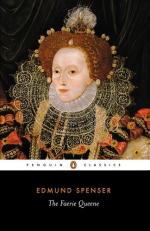This poem is one of the fruits of that intellectual awakening which first fertilized Italian thought in the twelfth century, and, slowly spreading over Europe, made its way into England in the fifteenth century. The mighty impulse of this New Learning culminated during the reign of the Virgin Queen in a profound quickening of the national consciousness, and in arousing an intense curiosity to know and to imitate the rich treasures of the classics and romance. Its first phase was the classical revival. The tyrannous authority of ecclesiasticism had long since been broken; a general reaction from Christian asceticism had set in; and by the side of the ceremonies of the church had been introduced a semi-pagan religion of art—the worship of moral and sensuous beauty. Illiteracy was no longer the style at court. Elizabeth herself set the example in the study of Greek. Books and manuscripts were eagerly sought after, Scholars became conversant with Homer, Plato, Aristotle, and the great tragic poets Sophocles, Euripides, and Aeschylus; and translations for the many of Vergil, Ovid, Plautus, Terence, and Seneca poured forth from the printing-presses of London. The English mind was strongly tempered by the idealistic philosophy of Plato and Aristotle, and the influence of Latin tragedy and comedy was strongly felt by the early English drama.
Along with this classical culture came a higher appreciation of the beauty of mediaevalism. The romantic tendency of the age fostered the study of the great epics of chivalry, Ariosto’s Orlando Furioso and Tasso’s Jerusalem Delivered, and of the cycles of French romance. From the Italian poets especially Spenser borrowed freely. Ariosto’s fresh naturalness and magic machinery influenced him most strongly, but he was indebted to the semi-classical Tasso for whole scenes. On the whole, therefore, Spenser’s literary affinities were more with the Gothic than the classical.
Spenser was also the spokesman of his time on religious questions. The violent controversies of the Reformation period were over. Having turned from the beliefs of ages with passionate rejection, the English people had achieved religious freedom, and were strongly rooted in Protestantism, which took on a distinctly national aspect. That Calvinism was at that time the popular and aristocratic form of Protestantism is evident from references in the Faerie Queene.
Spenser lived in the afterglow of the great age of chivalry. The passing glories of knighthood in its flower impressed his imagination like a gorgeous dream, and he was thus inspired to catch and crystallize into permanent art its romantic spirit and heroic deeds. Into the framework of his romance of chivalry he inserted a veiled picture of the struggles and sufferings of his own people in Ireland. The Faerie Queene might almost be called the epic of the English conquest of Ireland. The poet himself




